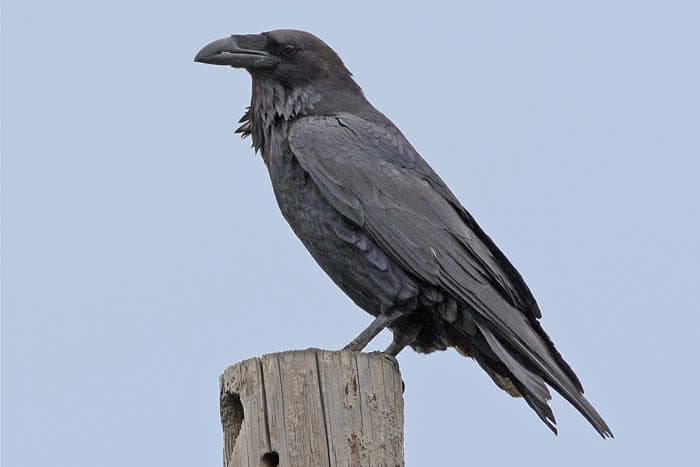Common raven / Kolkrabe (Corvus corax)
Wikipedia A-Z Animals Vogelwarte BirdLife ZH ornitho.ch bird-song.ch Audubon AllAboutBirds Xeno-Canto BirdID NABU YouTubeEIn Kolkrabe wollte anscheinend etwas zum Fressen von uns. 2024-09-14 12:18:14 Fanel/Chablais de Cudrefin und La Sauge
ISO 200
Exposure 1/320
Observations
First documented observation: 2021-03-10 in Wetzikon. Most recent observation: 2025-02-18 in Canary Islands.Description
Classification: Genus Crows (Corvus); Family Corvidae (Corvidae)This bird appears across the great seas in the following continents: Europe, North America, Africa.
The raven is often mentioned in word puzzles as the largest songbird.
Good to know:Other: A flock of ravens may be called an unkindness [Literary names of groups and flocks]
Etymology:
Appearance and identification:
Vocalization:
Seasonal behavior
Year-round bird Breeding: 02-20 - 06-09Other Details
Physical details
Physical details: length=64 cm, wingspan=120-150 cm, weight=800-1560 gHabitats: Mountain
Vocalisation
Song: Automatically generated from Xeno-Canto recording. The raven is often mentioned in word puzzles as the largest songbird. Song attributes: Frequency:XC779842 - Northern Raven - Corvus corax corax - call recorded in Sweden.
♫

Calls: The raven is often mentioned in word puzzles as the largest songbird. Graak!
Call attributes: Call melody: non-musical, slow, Frequency: low (1-3 KHz), Special sounds: cawing.
Media
|
Kolkrabe - der Schnabel ist wichtig für Erkennung. 2025-02-17 16:31:50 Canary Islands ISO 200 Exposure 1/320 |
Kolkrabe bei einem Sichtpunkt. Hier sieht man Raben, nicht Krähen. 2025-02-18 13:20:56 Canary Islands ISO 200 Exposure 1/400 |
MerlinBirdID meint Kolkrabe - ich kann Krähen und Raben immer schlecht unterscheiden, muss daran arbeiten! 2024-05-22 18:02:24 Fanel/Chablais de Cudrefin und La Sauge ISO 500 Exposure 1/1250 |
|
Nach BirdId Kolkrabe, im Flug beim Greifensee. 2022-07-18 08:45:50 Greifensee Exposure 1/1600 |
Kolkrabe nah beim Nest. 2022-05-22 09:37:28 Leuk Exposure 1/500 |
Kolkraben mit drei kleinen. 2022-05-22 09:37:00 Leuk Exposure 1/640 |
Kolkrabe Ruf im Biotop. Greater Fehraltorf 2024-09-12 16:37:00
♫
Additional Images
|
Andere sagten hier wären Kolkraben, Dohlen und Saatkrähe zusammen mit hellen Schnabeln. 2022-05-21 13:34:38 Switzerland Exposure 1/1600 |
Zoff zwischen Habicht und wahrscheinlich Kolkrabe - Spannweite Verhältnis des Schwarzen etwa 50 Prozent mehr. 2021-10-30 11:42:48 Greifensee Exposure 0.001 |
Kolkrabe am Aabach, Wetzikon. 2021-03-10 09:49:56 Wetzikon Exposure 1/2000 |
|
Kolkrabe am Aabach, Wetzikon. 2021-03-10 09:49:56 Wetzikon Exposure 1/2000 |

Wikipedia - Kolkrabe oder Corvus corax head profile. Source: WIKIPEDIA Wikipedia - Kolkrabe oder Corvus_corax_head_profile.jpg  Canon EOS 7D
Shutter speed 9.375
Canon EOS 7D
Shutter speed 9.375ISO 400 Exposure 1/640 |

Vogelwarte - Kolkrabe. Source: VOGELWARTE Vogelwarte - Kolkrabe.jpg 
|